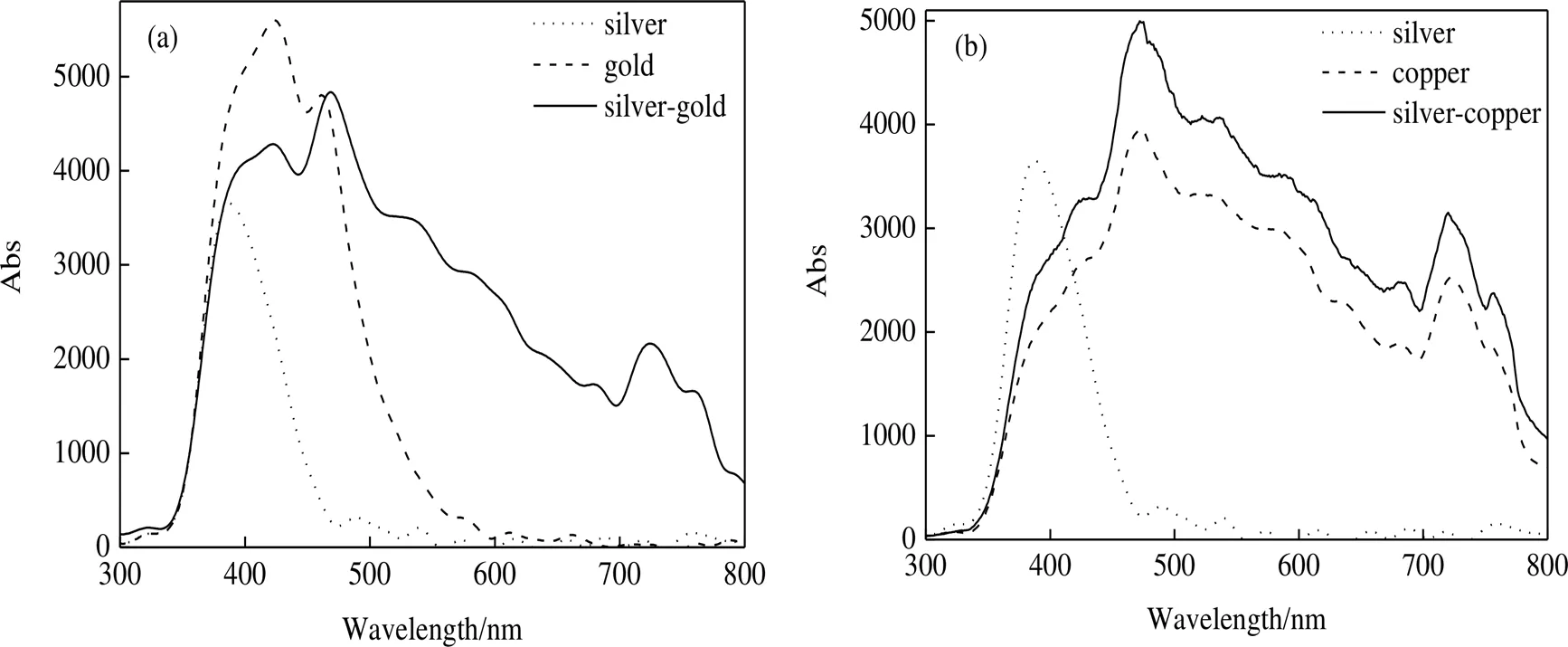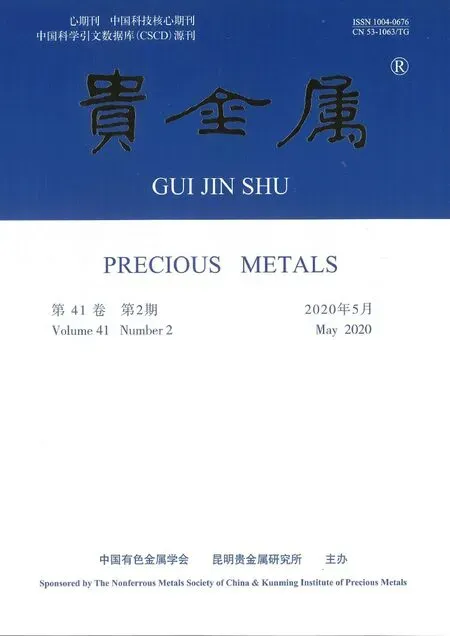贵金属团簇在染料敏化太阳能电池中的研究进展
李维银,张永莉,马海军,张 莎,海 莲
贵金属团簇在染料敏化太阳能电池中的研究进展
李维银,张永莉,马海军,张 莎,海 莲
(北方民族大学 电气信息工程学院 物理与光电信息功能材料重点实验室,银川 750021)
贵金属团簇可用作太阳能电池的染料敏化剂。综述了银、金、铜、银-金和银-铜团簇的制备方法、团簇的粒径和紫外-可见吸收光谱特征,比较了几种贵金属团簇敏化太阳能电池的性能。对比表明,双金属团簇作为染料敏化剂时比单金属团簇具有更好的性能,并可降低成本。要实现贵金属团簇的实际应用,需加强在合成方法、电极的制备和电解液在电池中的作用机理等方面的研究。
太阳能电池;贵金属团簇;染料敏化剂;性能;光电转化效率
为满足不断增长的能源需求和解决化石燃料对环境的影响,人们在不断地寻找和开发新能源[1-2]。太阳能电池技术通过光伏系统将太阳能转化成电能,是当前最重要的新能源之一。在第三代太阳能电池中,染料敏化太阳能电池因制作工艺简单、成本低、电池材料来源丰富,成为今后发展趋势之一。
染料敏化太阳能电池最早是1991年由O'Regan等[3]提出的,其采用TiO2电极,涂上有机染料作为光敏化剂。染料敏化剂受太阳光激发产生电子,再将产生的电子输入到半导体(如TiO2)的导带中实现光伏转化,在此过程中染料敏化剂对光的吸收能力是整个电池效率的关键因素[4]。目前,效率较高的染料大多是以N3[5]、N719[6]为代表的钌系多吡啶配合物。虽然它们的光电转化效率均超过10%,但是这些染料摩尔消光系数较低、稳定性也较差。后来发展了以Z907[7]为代表的稳定性较高的两亲性染料,但摩尔消光系数还是较低;Bai等[8]制备了摩尔消光系数较高的染料C101。由于钌系多吡啶染料成本较高,稳定性较低,因此研发成本较低、稳定性较高的染料成为本领域的热点,如蒋生辉等[9]研制了一种噻吩-三苯胺染料,光电转化效率达9.1%。
近年来,对贵金属团簇光学性能的理论研究发现,贵金属团簇在可见光范围内具有吸收性能[10-23]。实验上实现了贵金属团簇作为染料敏化剂制备的太阳能电池[24-34],其中一种谷胱甘肽保护的金团簇制备的太阳能电池的转化效率高于2%[24]。双金属团簇敏化剂太阳能电池是当前的研究热点。Kobayashi等[35]制备了一种双金属金-银团簇,为双金属团簇的应用提供了基础;本团队研究[36-38]发现,相比于单一金属团簇敏化太阳能电池,双金属团簇敏化太阳能电池提高了电池的短路电流密度和光电转化效率,并且保持了电流的稳定性。金属团簇作为敏化剂大大降低了太阳能电池的成本,并且提高了电池的稳定性。本文综述贵金属团簇的制备和性能,以及它们在敏化太阳能电池中的应用。
1 贵金属团簇的制备
金属团簇作为染料敏化剂,是太阳能电池的关键组成部分。制备稳定性较好、光学性能优异的金属团簇直接决定着太阳能电池的性能。制备团簇的方法主要有凝聚相合成法、真空合成法和气相合成法等3种。凝聚相合成法主要是用化学法制备金属、半导体和化合物分子团簇。真空合成法是用几至几十千电子伏特载能粒子轰击固体表面,使固体表面溅射出各种次级粒子,包括电子、离子、原子和团簇等。气相合成法主要是将物质元素或化合物放在低压的惰性气体腔室的蒸发皿中,高温加热至气化,与惰性原子或分子碰撞,迅速冷却形成原子团簇;或者利用光学聚焦系统把激光聚焦到很小的区域,使焦耳级的能量作用到固体靶表面,靶表面微区温度极高,发生离子发射或中性粒子蒸发,再用惰性气体冷却,聚集成团簇。通常凝聚相合成法制备的团簇直径范围从几十到几百纳米,目前已可用此法制备小于5 nm的粒子。本文主要介绍属凝聚相合成法的谷胱甘肽保护的化学合成金团簇方法。
一种方法是低温直接合成方法[25-29, 39-40]。主要材料为高纯氯金酸((HAuCl4∙4H2O)>99%),高纯硝酸银((AgNO3)>99.8%),高纯硝酸铜((Cu (NO3)2∙3H2O)>99.9%),硼氢化钠((NaBH4)>98%),还原型谷胱甘肽(98%)和高纯甲醇(99.8%)。将谷胱甘肽和金属盐分别溶在少量的去离子水中,加入0℃的甲醇,迅速将上述溶液混合搅拌30 min。在搅拌的过程中,加入新制备NaBH4水溶液[25-31, 35-39]或者通入CO气体2 min[32-33],25℃持续搅拌12 h。将得到的溶液离心10 min,获得的沉淀物用甲醇清洗干净,再将这些沉淀在25℃真空干燥。制备得到贵金属团簇分散在水溶液中备用。
另一种方法是水浴合成法[24, 34, 40]。在室温下将高纯氯金酸和还原型谷胱甘肽在去离子水中混合,再将混合液搅拌到无色状态,然后在70℃水浴24 h。将上述溶液用乙腈提纯再结晶生成金团簇,用去离子水清洗,最后得到的金团簇分散在水溶液中。
2 贵金属团簇的性质
2.1 粒径分布
利用NaBH4和CO直接还原法得到贵金属团簇-纳米颗粒的高分辨透射电镜图像如图1所示。谷胱甘肽保护的纳米颗粒直径在1~5 nm之间。用XRD测得低温合成的银、金、铜[28]和银-金[35]纳米颗粒的核心平均直径分别为0.85、1.02、0.80和0.61 nm;水浴法[24, 34, 40]制备得到金团簇的直径为1.0~1.6 nm。
2.2 紫外-可见吸收光谱
谷胱甘肽保护的贵金属团簇的紫外-可见吸收光谱如图2所示。银、金、铜、银-金和银-铜团簇的最大吸收峰分别为388、424、474、468和472 nm。
从图2(a)可见,银-金双金属团簇的紫外-可见吸收光谱发生了红移,吸收波长500 nm是谱线形状的分界线。当波长小于500 nm时,银-金双金属团簇的紫外-可见吸收光谱形状与单一金属团簇的紫外-可见吸收光谱形状非常相似。波长大于500 nm,吸收光谱曲线形状差异比较大:银-金双金属团簇表现出更宽的吸收范围;单一金属团簇吸收性能降低,几乎为零。由图2(b)可见,银-铜双金属团簇的紫外-可见吸收光谱相对于银团簇发生了红移,但与铜团簇的紫外-可见吸收光谱非常相似,这种现象成因复杂,需要进一步研究。
金或银团簇的紫外-可见吸收光谱吸收范围比较窄,铜、银-金和银-铜团簇的紫外-可见吸收光谱吸收范围比较宽。所以,通过掺杂单金属团簇合成为双金属团簇,不但可以改变单金属团簇的紫外-可见吸收光谱吸收峰的位置,而且还可以调制它们的范围,这与理论计算中银-铜[10, 12-19, 23]和银-金[20-21]的紫外-可见吸收光谱调制作用相似。银-金和银-铜双金属团簇光吸收范围更宽,成本更低,具有作为太阳能电池染料敏化剂的前景。

图1 银、金、铜、银-金和银-铜金属团簇的高分辨率透射电镜(HRTEM)图像[37, 39]

图2 银、金和银-金(a)以及银、铜和银-铜(b)团簇紫外-可见吸收光谱[37, 39]
3 不同贵金属团簇太阳能电池的性能
贵金属团簇染料敏化太阳能电池的结构示意如图3所示。它由3层结构组成,即金属团簇修饰的TiO2电极、钴基电解液和铂对电极组装成的三明治结构;外层用导电玻璃(FTO)包夹。利用丝网印刷将纳米晶TiO2涂在FTO上得到TiO2电极,再将TiO2电极浸泡在金属团簇溶液中得到金属团簇修饰的TiO2电极。在金属团簇修饰的TiO2电极和铂对电极之间注入钴基电解液制备成简易太阳能电池。

图3 贵金属团簇染料敏化太阳能电池的结构示意
用AM1.5模拟太阳光,银、金、铜、银-金和银-铜金属团簇制备的敏化太阳能电池的电流密度和电压变化曲线如图4所示,开路电压、电流密度、填充因子以及光电转换效率见表1。图5描述了这几种团簇染料敏化太阳能电池的电流密度随时间的变化曲线。

图4 银、金和银-金(a)以及银、铜和银-铜(b)团簇敏化太阳能电池的电流密度-电压变化曲线[36, 38]
表1 贵金属团簇染料敏化太阳能电池的性能

Tab.1 Photovoltaic performance of the noble metal cluster- sensitized solar cells
从表1可知,金团簇[24]作为染料敏化剂时,各项性能(包括开路电压、短路电流密度、填充因子以及光电转化效率)都明显提高,其中转化效率达到2.36%且稳定性好。结合图4和表1的数据,本文笔者所进行的研究[36, 38]中,银、金、铜、银-金和银-铜团簇作为染料敏化剂时,对应的性能参数都低于文献[24]所报道的数值,可能由于团簇的合成方法、实验环境条件、载流子在传输过程中数量及协同作用等不同。但是以自身数据作比较,只有TiO2电极时,开路电压很小,对应的电流密度也非常小;当有金属团簇作为敏化剂时,对应性能参数都比只有TiO2电极时要大,其变化趋势与文献[24]一致。

图5 银、金和银-金(a)以及银、铜和银-铜(b)团簇敏化太阳能电池的电流密度-时间变化曲线[36, 38]
以双金属团簇作为敏化剂时,太阳能电池的性能发生了一些变化。银-金团簇敏化太阳能电池的开路电压高于银团簇敏化太阳能电池的开路电压,低于金团簇敏化太阳能电池的开路电压;银-金团簇敏化太阳能电池的短路电流密度比金和银团簇敏化太阳能电池的短路电流密度大好几倍。银-金双金属团簇敏化太阳能电池的填充因子均小于金或银团簇敏化太阳能电池的填充因子,它的转化效率是金或银团簇敏化太阳能电池的5倍。双金属银-铜团簇敏化太阳能电池的变化趋势与银-金团簇敏化太阳能电池的变化趋势相似,双金属银-铜团簇敏化太阳能电池的短路电流密度和转化效率都大于单一银或铜团簇敏化太阳能电池的短路电流密度和转化效率。
从图5可知,银、金和银-铜团簇染料敏化太阳能电池的电流密度随着测试时间的延长而逐渐变小。其中银-铜团簇染料敏化太阳能电池的电流密度随着测试时间的延长,初始时比较快地减少,随后减少的比较慢,最后趋于稳定;铜和银-金团簇染料敏化太阳能电池的电流密度随着测试时间的延长几乎保持不变。因此,可以推断,贵金属团簇作为太阳能电池的染料敏化剂,增强了太阳能电池的性能,可降低太阳能电池的成本。
4 结语
贵金属团簇可作为太阳能电池的染料敏化剂,其中双金属团簇有利于提高性能,降低成本,具有一定的应用前景。目前有少量贵金属团簇敏化太阳能电池的研究,但团簇的合成方法、电极的制备方法和电解液在电池中的作用机理等因素仍不明确,其光电转化效率还不高,整体稳定性也不理想,尚达不到实际应用要求,需通过进一步的研究提高其性能和转化率。
[1] HOFFERT M, CALDEIRA K, JAIN A. Energy implications of future stabilization of atmospheric CO2content[J]. Nature,1998, 395(6705): 881.
[2] LEWIS N S, NOCERA D G. Powering the planet: Che- mical challenges in solar energy utilization[J]. Proceedings of the National Academy of Sciences,2006, 103(43): 15729.
[3] O'REGAN B, GRATZEL M. A low-cost, high-efficiency solar cell based on dye-sensitized colloidal TiO2films[J]. Nature,1991, 353: 737.
[4] 徐长志, 肖斌, 柳清菊. 染料敏化太阳能电池的研究进展[J]. 材料导报,2014, 28(4): 149.
XU C, XIAO B, LIU Q. Research progress in dye- sensitized solar cells[J]. Materials reports, 2014, 28(4): 149.
[5] NAZEERUDDIN M K, KAY A, RODICIO I, et al. Conversion of light to electricity by cis-X2bis(2,2'- bipyridyl-4,4'-dicarboxylate) ruthenium(II) chargetransfer sensitizers (X = Cl-,Br-,I-,CN-,and SCN-) on nano- crystalline TiO2electrodes[J]. Journal of the American Chemical Society, 1993, 115(14): 6382.
[6] NAZEERUDDIN M K, ANGELIS F D, FANTACCI S, et al. Combined experimental and DFT-TDDFT compu- tational study of photo-electro-chemical cell ruthenium sensitizers[J]. Journal of the American Chemical Society, 2005, 127: 16835.
[7] WANG P, ZAKEERUDDIN S M, MOSER J E, et al. A stable quasi-solid-state dye-sensitized solar cell with an amphiphilic ruthenium sensitizer and polymer gel electrolyte[J]. Nature materials,2003, 2(6): 402.
[8] BAI Y, CAO Y, ZHANG J, et al. High-performance dye- sensitized solar cells based on solvent-free electrolytes produced from eutectic melts[J]. Nature materials,2008, 7(8): 626.
[9] 蒋生辉, 周维平, 谭卓, 等. 基于不同取代基的噻吩-三苯胺染料敏化剂的合成与光伏性能[J]. 中国科学: 化学,2011, 41(6): 982.
JIANG S, ZHOU W, TAN Z, et al. Synthesis and photovoltaic performance of dye-sensitizers based on thiophene-triphenylamine with varied substituents[J]. Scientia sinica chimica, 2011, 41(6): 982.
[10] LI W, CHEN F. A density functional theory study of structural, electronic, optical and magnetic properties of small Ag-Cu nanoalloys[J]. Journal of nanoparticle research, 2013, 15(7): 1809.
[11] LI W, CHEN F. Effect of transition metal (Fe, Cu, Ni, Rh)-doped on optics of plasmon resonances of small silver chains[J]. Applied physics A,2013, 113(3): 543.
[12] LI W, CHEN F. Effect of Cu-doped site and charge on the optical and magnetic properties of 55-atom Ag cluster: A density functional theory study[J]. Computational materials science,2014, 81: 587.
[13] LI W, CHEN F. Structural, electronic and optical properties of 7-atom Ag-Cu nanoclusters from density functional theory[J]. The European physical journal D,2014, 68(4): 91.
[14] LI W, CHEN F. Optical, Raman and vibrational properties of closed shell Ag-Cu clusters from density functional theory: The influence of the atomic structure, exchange- correlation approximations and pseudopotentials[J]. Physica B:Condensed matter, 2014, 443: 6.
[15] LI W, CHEN F. Effect of multiple exciton generation on ultraviolet-visible absorption of Ag-Cu clusters: Ab initio study[J]. Journal of alloys and compounds,2014, 607: 238.
[16] LI W, CHEN F. Multiple exciton generation in Ag and Ag-Cu quantum clusters by visible wavelength excitation [J]. Journal of nanoparticle research,2014, 16(8): 2498.
[17] LI W, CHEN F. Ultraviolet-visible absorption, Raman, vibration spectra of pure silver and Ag-Cu clusters: A density functional theory study[J]. Physica B:Condensed matter,2014, 451: 96.
[18] LI W, CHEN F. Effects of shape and dopant on structural, optical absorption, Raman, and vibrational properties of silver and copper quantum clusters: A density functional theory[J]. Chinese physics B,2014, 23(11): 117103.
[19] LI W Y, ZHANG S, HAI L. Structural, optical, electronic, and magnetic properties of Ag-Cu bimetallic clusters: a density functional theory study[J]. Journal of nanoparticle research,2018, 20(7): 188.
[20] CHEN F, JOHNSTON R L. Structure and spectral characteristics of the nanoalloy Ag3Au10[J]. Applied physics letters,2007, 90(15): 153123.
[21] CHEN F, JOHNSTON R L. Charge transfer driven surface segregation of gold atoms in 13-atom Au-Ag nanoalloys and its relevance to their structural, optical and electronic properties[J]. Acta materialia,2008, 56(10): 2374.
[22] MA W Q, CHEN F Y. Optical and electronic properties of Cu doped Ag clusters[J]. Journal of alloys and compounds,2012, 541: 79.
[23] RAO Y, LEI Y M, CUI X Y, et al. Optical and magnetic properties of Cu-doped 13-atom Ag nanoclusters[J]. Journal of alloys and compounds,2013, 565: 50.
[24] CHEN Y S, CHOI H, KAMAT P V. Metal-cluster- sensitized solar cells. a new class of thiolated gold sensitizers delivering efficiency greater than 2%[J]. Journal of the American Chemical Society,2013, 135(24): 8822.
[25] KOGO A, SAKAI N, TATSUMA T. Photoelectro- chemical analysis of size-dependent electronic structures of gold clusters supported on TiO2[J]. Nanoscale,2012, 4(14): 4217.
[26] KOGO A, TAKAHASHI Y, SAKAI N, et al. Gold cluster- nanoparticle diad systems for plasmonic enhancement of photosensitization[J]. Nanoscale,2013, 5(17): 7855.
[27] SAKAI N, NAKAMURA S, TATSUMA T. Photovoltaic properties of TiO2loaded with glutathione-protected silver clusters[J]. Dalton transactions,2013, 42(45): 16162.
[28] SAKAI N, TATSUMA T. One-step synthesis of glutathione-protected metal (Au, Ag, Cu, Pd, and Pt) cluster powders[J]. Journal of materials chemistry A,2013, 1(19): 5915.
[29] SAKAI N, TATSUMA T. Photovoltaic properties of glutathione-protected gold clusters adsorbed on TiO2electrodes[J]. Advanced materials,2010, 22(29): 3185.
[30] CHEVRIER D M, RAICH L, ROVIRA C, et al. Molecular-scale ligand effects in small gold-thiolate nano-clusters[J]. Journal of the American Chemical Society,2018, 140(45): 15430.
[31] CHEN T K, FUNG V, YAO Q F, et al. Synthesis of water-soluble [Au-25(SR)(18)](-) using a stoichiometric amount of NaBH4[J]. Journal of the American Chemical Society,2018, 140: 11370.
[32] LUO Z T, NACHAMMAI V, ZHANG B, et al. Toward understanding the growth mechanism: tracing all stable intermediate species from reduction of Au(I)-thiolate complexes to evolution of Au-25 nanoclusters[J]. Journal of the American Chemical Society,2014, 136(30): 10577.
[33] YU Y, LUO Z T, CHEVRIER D M, et al. Identification of a highly luminescent Au-22(SG)(18) nanocluster[J]. Journal of the American Chemical Society,2014, 136(4): 1246.
[34] LUO Z T, YUAN X, YU Y, et al. From Aggregation- induced emission of Au(I)-thiolate complexes to ultrabright Au(0)@Au(I)-thiolate core-shell nanoclusters [J]. Journal of the American Chemical Society,2012, 134: 16662.
[35] KOBAYASHI R, NONOGUCHI Y, SASAKI A, et al. Chiral monolayer-protected bimetallic Au-Ag nano- clusters: Alloying effect on their electronic structure and chiroptical activity[J]. Journal physical chemistry C,2014, 118(28): 15506.
[36] LI W, CHEN F. Alloying effect on performances of bimetallic Ag-Au cluster sensitized solar cells[J]. Journal of alloys and compounds,2015, 632: 845.
[37] SHAHZAD N, CHEN F Y, HE L R, et al. Silver-copper nanoalloys - An efficient sensitizer for metal-cluster- sensitized solar cells delivering stable current and high open circuit voltage[J]. Journal of power sources,2015, 294: 609.
[38] 李维银. 银铜双金属团簇的结构、电子和光学性能[D]. 西安: 西北工业大学, 2015.
LI W Y. Structural, electronic and optical properties of silver-copper bimetallic clusters[D]. Xi'an: Northwestern Polytechnical University, China, 2015.
[39] FARRAG M, TSCHURL M, HEIZ U. Chiral gold and silver nanoclusters: preparation, size selection, and chiroptical properties[J]. Chemistry of materials,2013, 25(6): 862.
[40] WANG H K, CHEN F Y, LI W Y, et al. Gold nanocluster- sensitized TiO2nanotubes to enhance the photocatalytic hydrogen generation under visible light[J]. Journal of power sources,2015, 287: 150.
Research Progress of Noble Metal Clusters in Dye-sensitized Solar Cells
LI Wei-yin, ZHANG Yong-li, MA Hai-jun, ZHANG Sha, HAI Lian
(Key Laboratory of Physics and Photoelectric Information Functional Materials, School of Electrical and Information Engineering, North Minzu University, Yinchuan 750021, China)
Noble metal clusters can be used as dye sensitizers for solar cells. The preparation methods, sizes, and UV-vis absorption spectra characteristics of silver, gold, copper, silver-gold and silver-copper clusters are reviewed, and the performances of several noble metal cluster sensitizers solar cells are compared. The comparison results show that bimetallic clusters have better performance than monometallic clusters when they are used as sensitizers solar cells and can reduce costs. In order to realize the practical application of noble metal clusters, it is necessary to strengthen the research on the synthesis methods of clusters, the preparations of electrodes, and the reaction mechanisms of electrolyte in solar cells.
solar cell; noble metal cluster; dye-sensitizer; photoelectric conversion efficiency
TM914.4;O621.3
A
1004-0676(2020)02-0089-07
2019-08-02
国家自然科学基金(11764001);宁夏自然科学基金(2018AAC03122);宁夏高等学校科学技术研究项目(NGY2017167);宁夏高等学校一流学科建设项目(NXYLXK2017A07);中央高校基本科研业务费专项资金;北方民族大学人才引进项目
李维银,男,博士,研究方向:贵金属团簇性能及应用。E-mail:lwy744019@163.com

